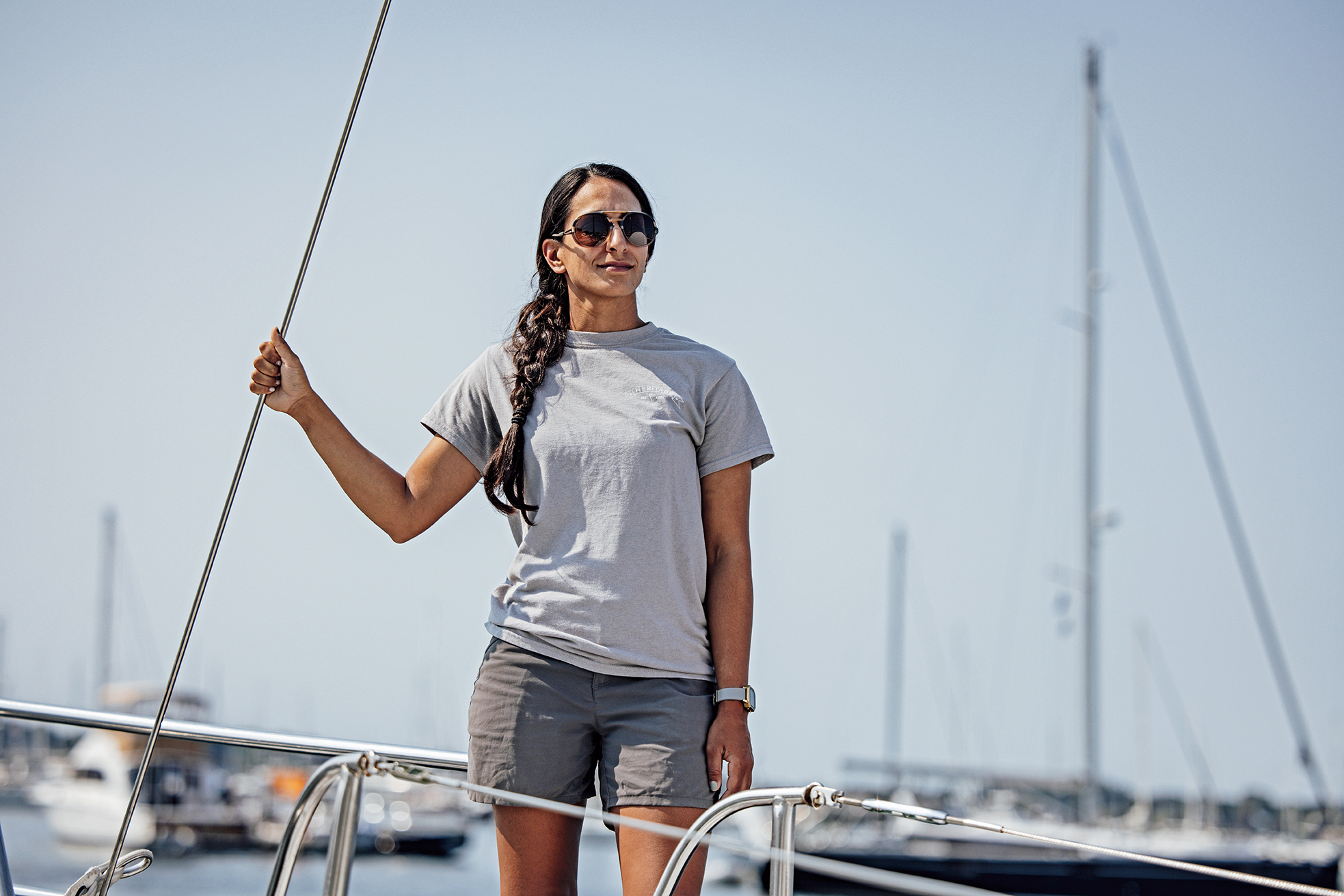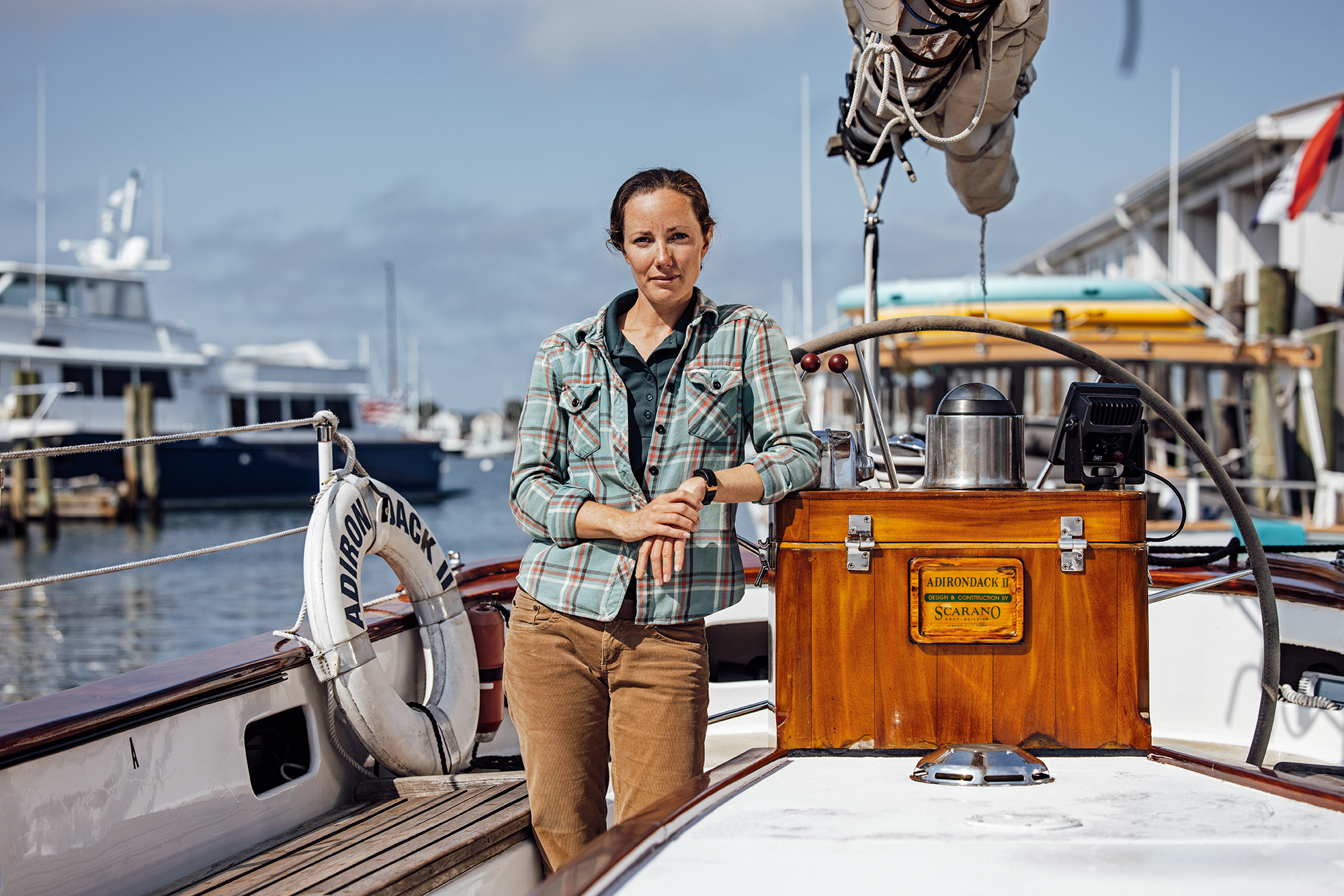Women Take the Helm
Local Sailing Community Elevating Female Sailors
By Helena Touhey| Cover Image by Onne van der Wal“I’ve seen a lot of posts today highlighting the many talented women in sailing,” she wrote, “but not many discussing how we can encourage more women and girls to stick with the sport.”
She then shared an article from Sailing World, headlined, “How to Get More Women in Competitive Sailing,” with a subhead that read, “What’s really driving women away from the sport is a culture within the sport itself. Think about it.”
The article, posted that day, was a column by Kelly McGlynn, a sailor who competed at Brown University before graduating in 2015 and who had talked to dozens of peers about their experiences on the water. And, according to Patnaude’s Instagram story, McGlynn’s piece was being shared among women in the sailing community.
“This article expertly discusses the importance of fostering confidence, tackling imposter syndrome, and creating visible role models in a majority male-dominated realm,” Patnaude wrote. She then proceeded to annotate the article, highlighting passages she felt were especially noteworthy, such as: “In adult sailing, the most prevalent way women are overlooked is in crew decisions. It’s too common for women to be asked to round out a team in a way where the men expect minimal contribution to the sailing from them.”
She then underlined the next two sentences, in a soft pink color, a subtle but evocative choice: “When women aren’t expected to contribute more than being the right weight, it’s harder for them to develop the skills for other jobs. And it reinforces the misguided perception of women’s limited role in the boat.” This is in reference to race boats, where the crew collectively cannot weigh more than a certain amount, per the rules of the race, because of how it might impact the way the boat moves through the water.
In fact, when Patnaude and I met at a coffee shop the next day, she told me she was just coming off a few weeks of watching what she was eating because of an upcoming race—and had just learned the rest of the crew, all men, were not being nearly as vigilant as she. In other words, she was the only one who had, in fact, been watching her weight.
As she eyed the cafe menu, she said this was frustrating, but also not all that surprising. After all, she’s a woman in a sport—and a profession—where women still have to prove their worth and demonstrate, literally, they are worth their weight.
In addition to crewing race boats, Patnaude is also the captain of Onawa, a position that puts her in the company of only a handful of other women working on Newport’s waterfront. Onawa, at 68 feet, is a classic 12-Meter—a vintage wooden boat.
It’s been proven time and again that women are capable mariners.

Shivani Sood, Captain of Heritage—a classic 12-Meter. Photo by Jesse Burke.
“I like being on the classic yachts because I like being a steward of something,” she said. Her first captain gig was on Columbia, another 12-Meter circa 1928, which she described as a “gentleman’s yacht.”
In Newport, she’s noticed more and more women taking the helm of these vessels, which she said is progress but also a way for boat owners, usually male, to give women captain’s jobs without giving them some of the bigger boat jobs. “A friend said to me, ‘This is their toy; this isn’t a real race boat; they’re only giving their toys to female captains,’” Patnaude recalled after she landed her job on Columbia. Her response: “If that’s the way we have to get the visibility of females in sailing, [then] that’s fine.”
Patnaude, 32, didn’t grow up in the sailing world. Her memories of sailing as a child include attending sail camp at Newport Yacht Club and crying the whole time. Something about the experience evoked a deep fear. She took up the sport later, in her mid-20s, when she wanted to stay in Newport. “I was way too rude to be a waitress,” she said, laughing. So she landed a job on the harbor and has been working since then on boats for nearly a decade. About five years after her first gig, Patnaude applied for her captain’s license, which she says she pursued with “the intention of proving I didn’t want to be a stewardess when I applied for jobs.”
Roles for Women
In the sailing world, yachting in particular, stewardess is still an active term used to denote women working on boats in certain roles, especially roles that involve cleaning and preparing meals and greeting guests.
Women, she noted, “aren’t given all the same experiences [and often] end up making sandwiches.” The captain’s license, she explained, was really something to put on her resume; it would be a distinguished credential, one that might help her earn more money and also more jobs.
“I didn’t intend to be a captain,” she said, a thought that might have been rooted in the fact that women captains are few and far between. Or at least they have been—in Newport, in recent years, this dynamic has been shifting, slowly, with more and more women not only obtaining their captain’s license but also getting jobs as captains.

Elise Huebner has been part of this shift. She’s the captain of schooner Adirondack II and sloop Eleanor, a job she took up two years ago and one that marked her first time using her captain’s license, which she had had for five years. Huebner, like Patnaude, originally applied for her license thinking it would be a useful credential, but without any plans to apply for a captain’s job.
She’s joined on the harbor by Shivani Sood, who she met several years ago through boat work. Sood is the captain of Heritage, another classic 12-Meter, which she owns with her husband, Zane. She applied for her license about four years ago, in part because she and Zane were entertaining the idea of going to Alaska, where he thought she could drive some of the smaller boats. Those plans didn’t pan out, but Sood got her license anyway. Once back in Newport and after working on other boats, Sood learned the captain of Heritage was leaving, which meant there was an open job. In fact, that captain, another woman, suggested Sood take over her job.
“It was her first captain gig, too. If she did it, why couldn’t I do it?” Sood said. “She passed the boat off to me. It was the right timing.”
Soon after, she and Zane were asked if they wanted to buy the boat, and they said “yes.” This summer was their third season as owners, and Sood, 31, continues to work as captain.
Like the other women, Sood has been subjected to a fair share of skepticism from people onboard, who question whether she’s equipped to captain the boat.
“It happens so often, it’s hard to recognize when it’s not happening,” she said.
Cassie Minto, 37, works as crew on Adirondack II and Eleanor, with Huebner as her captain, and freelances for a handful of other boats.
“My main goal is to become the most versatile crew member,” she said.
For now, she doesn’t plan to pursue her captain’s license. “I’m a supporting actress on these things,” she said, with a smile. We were seated at a cafe table. To her left was Huebner and across from her was Sood.
Adirondack II has had several female captains and crew members, part of a gradual progression to greater equity in Newport’s sailing community.
Photo by Onne van der Wal
Learning a New Trade
“I find I have to defend [Huebner] when guests ask, ‘Does she know what she’s doing?’” Minto said. “You have to pick and choose when you respond.” “How do you make light and put people in their place?” Huebner asked, her tone indicating there is no obvious answer to that question, especially not when her job as captain is to make sure passengers have a pleasant experience.
The sailing community, Sood remarked in response, is traditionally male, still behind the times, and to be women existing in this space is controversial.
“We are still trying to find equal footing,” she said. “Just to be in [this space] is so much in terms of changing people’s minds. I have to normalize my existence behind the helm,” Sood said.
Huebner, 33, recalled being told she looks “too young to be a captain” and asked, “when are you going back to school?”
“[Some people] have no confidence that we can do the job we’re there to do,” Minto said in response.
“[And] if we don’t laugh about it in the moment, then there’s another stereotype put on us,” Sood said. “I once had to tell a guy not to call me honey.”
“How about Captain Honey?” Minto interjected, and all three laughed. Then, more seriously, she said, “I’ve been really, really proud to be on boats with all female captains.”

“Other women have paved the way for us,” Minto said. She noted one person in particular, Rachael Slatterly, who was a captain of Adirondack II and Eleanor several years ago, at a time when there were even fewer women working on the harbor.
Slatterly grew up in Jamestown, in a mariner family, and started working on boats right out of high school for a company in Bristol that ran a small cruise line. She applied for a job as a deckhand and was told “we don’t hire female deckhands,” and was instead offered a job as a stewardess.
She accepted that job, which was a great experience and took her around the world. Still, she wanted to work in the deck department, and she quit when she realized that would never happen.
The company’s reasoning for not hiring her as a deckhand was because of maintaining separate male and female sleeping quarters, which Slatterly said was “totally bogus—it would have been totally fine.” But this was 20 years ago. She left that boat and landed jobs as a deckhand on various yachts, working her way up the chain of command. Then she pivoted into the educational sector, which in the sailing world is the tall ship sector.
Eventually Slatterly applied for her captain’s license. “Adirondack II was my first command—it was a fabulous place to start,” she said, explaining over. the phone that “Newport Harbor is one of the busiest harbors in the world,” and the experience of captaining a schooner is invaluable.
That summer, Slatterly recalls, there was “just me and one other female captain” working on the entire harbor.
“Other captains would comment that we didn’t need to say the name of the vessel when we left the slip because they recognized our voices,” to which she would respond: “Well, it’s legally required that I say the name of the boat.”
She laughed—an exasperated sort of laugh.
“I think it’s important for there to be women in command, for there to be representation at the helm,” she said, noting that the scene in Newport was never hostile, but she certainly experienced her share of sexism during her sailing career.
Standing on the Shoulders of Giants
These days, Slatterly mostly farms in Exeter, where she lives with her husband and young child, although she still captains from time to time.
“I always say I am standing on the shoulders of giants—all of the women before me who paved the way,” she said, agreeing that she has helped pave the path even further. “It’s been proven time and again that women are capable mariners,” she added.
Slatterly, along with Minto, Sood, and Huebner, all worked for, at some point, industry veteran Helen Vaughan, the manager of Sailing Excursions, which oversees Adirondack II and Eleanor.
“I always want one of our captains to be a woman—at least one,” Vaughan said, explaining there is work for two full-time captains and one part-time captain.
She was speaking on the phone from Florida, not yet returned to Newport for the summer season. She’s been the manager at Sailing Excursions for a dozen years and a sailor all her life. Vaughan remembers when she met Huebner, and how she had had her captain’s license for about five years and still hadn’t used it.
“When you get your captain’s license, you want to be a captain,” Vaughan said.
She hired Huebner and made sure she got the training she needed to become a captain. When asked about the specific experiences of women captains working on the boats, Vaughan noted some tourists have been known to make offhand comments.
“Older people, men, have more trouble with it than the community,” she said. “I think it’s a slow progression, but a progression to equality.”
This past summer, Adirondack II hosted a group of Sea Scouts composed of women ages 14 to 20 interested in learning about sailing, who went out on the harbor with an entirely female crew. Vaughan said she hoped the young women would take from the experience that they too can work on boats.
“It’s really fun to see [an increase of] female captains on Newport Harbor,” Vaughan added, saying it indicates a changing culture. “You [also] see so many more women racing in sailing than you used to.”
She, like the others, isn’t sure if this change is reflective of sailing communities everywhere, but it’s certainly representative of Newport and the local culture. “There is a part of me that says Newport is kind of unique,” she said, recalling how, when she began racing many years ago,
Newport was the first place she encountered women crews sailing together. Patnaude, the captain of Onawa, says she’s observed a shift in Newport, one where women continue to support and help each other gain and leverage new experiences and opportunities. Like Sood, Patnaude landed her first captain job because the outgoing captain was a woman, a woman who thought of her and suggested she take over. And since becoming a captain of Onawa, she has been able to hire more women. Currently, four of her 16 crew members are women.
“I may not have the most experience on the boat,” she said, “but I have a position where I can put as many girls on the boat as possible.”
Contact Us
Telephone: (401) 874-6805
Email: allard@uri.edu
Contributor Guidelines
Please review submission guidelines to be considered. d

